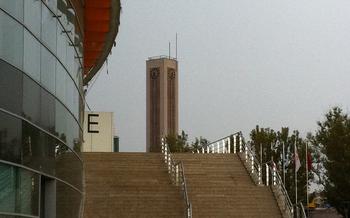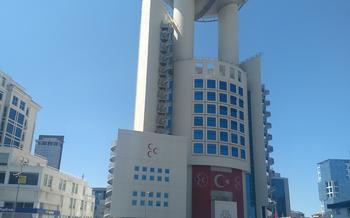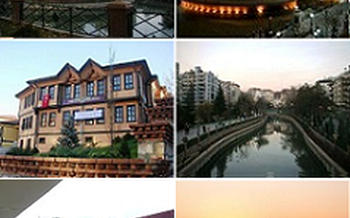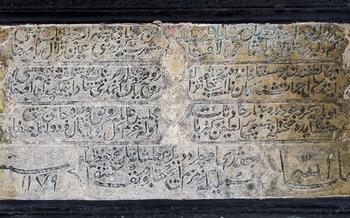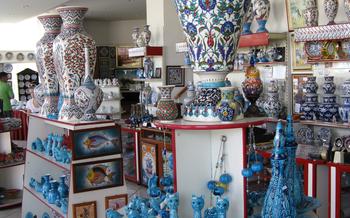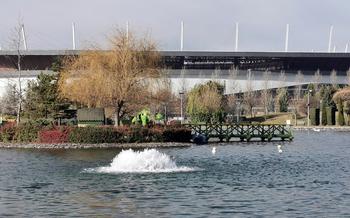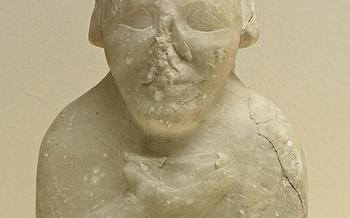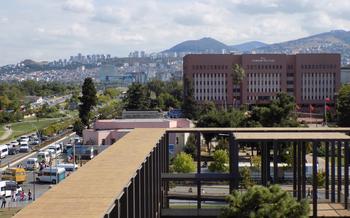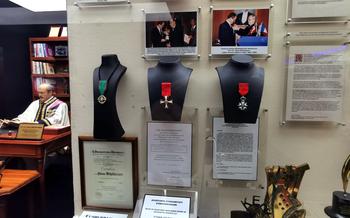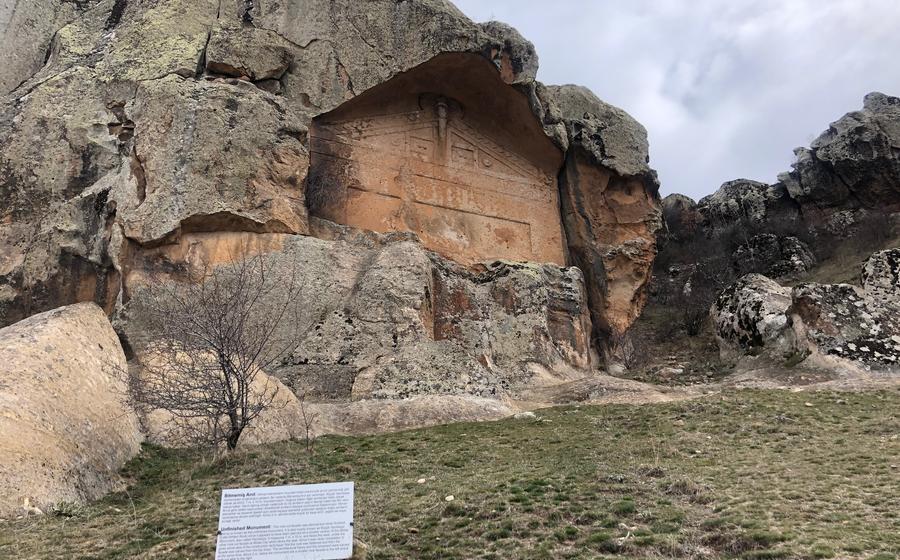
Midas Monument
- A Journey to Ancient Phrygia: Unveiling the Midas Monument
- Stepping into the Past: Exploring the Tumulus
- Unraveling the Mysteries of the Midas Touch
- A Masterpiece of Stone: The Lion Monument
- Delving into the Gordion Museum: A Treasury of Phrygian Artifacts
- Culinary Adventure: Savoring Local Delights
- Shopping for Souvenirs: A Piece of Phrygia to Take Home
- Unforgettable Accommodation: Where to Stay in Eskişehir
- Getting Around Eskişehir: Navigating the City
- Essential Travel Tips: Planning Your Trip
- Safety and Security: Ensuring a Smooth Journey
- Language and Communication: Bridging the Gap
- Cultural Etiquette: Respecting Local Customs
- Insider Tip: Off the Beaten Path
A Journey to Ancient Phrygia: Unveiling the Midas Monument
The Midas Monument, a remarkable testament to the ancient Phrygian civilization, stands as a captivating landmark in the heart of Turkey's Eskişehir province. Its historical significance is undeniable, as it serves as a poignant reminder of the Phrygian kingdom that once flourished in this region during the 8th century BC. The monument's strategic location, nestled amidst the picturesque Phrygian Valley, makes it easily accessible to travelers seeking to delve into the depths of Anatolia's rich past.
The Phrygians, an enigmatic people of Indo-European origin, played a crucial role in shaping the cultural tapestry of ancient Anatolia. Their kingdom, centered around the city of Gordion, served as a vital crossroads for trade and cultural exchange, connecting the East and the West. The Midas Monument, named after the legendary Phrygian king Midas, stands as a symbol of this vibrant civilization, inviting visitors to embark on a journey through time and discover the secrets of a bygone era.
Stepping into the Past: Exploring the Tumulus
The Midas Monument is not just a solitary structure; it is part of an elaborate tumulus, an ancient burial mound that holds significant cultural and historical value. The tumulus, which dates back to the 8th century BC, is a testament to the advanced engineering and architectural skills of the Phrygians. Constructed from large stones and earth, it stands as a symbol of their power and prosperity.
The tumulus is a remarkable example of Phrygian funerary architecture, providing valuable insights into their burial practices. It consists of a circular mound approximately 53 meters in diameter and 11 meters in height, with a stone retaining wall surrounding its base. The wall features carefully fitted polygonal stones, showcasing the Phrygians' mastery of stonework.
Excavations conducted at the site have revealed a wealth of artifacts, including pottery, jewelry, and tools, shedding light on the daily life and customs of the Phrygians. These discoveries have helped archaeologists piece together the history and culture of this ancient civilization, providing a glimpse into their beliefs and practices surrounding death and the afterlife.
Exploring the tumulus is a captivating experience, transporting visitors back in time to the world of the Phrygians. As you walk through the ancient burial chamber, you can imagine the elaborate ceremonies and rituals that took place here, honoring the memory of their departed leaders. The tumulus stands as a powerful reminder of the rich cultural heritage of the Phrygians, inviting visitors to delve deeper into their fascinating history.
Unraveling the Mysteries of the Midas Touch
The Midas Monument is not just a testament to ancient Phrygian culture; it is also inextricably linked to the legendary tales of King Midas and his golden touch. According to Greek mythology, Midas was a greedy king who was granted a wish by the god Dionysus. Midas wished that everything he touched would turn to gold, but he soon realized the folly of his desire when his food, drink, and even his beloved daughter turned into solid gold.
The Midas touch has been interpreted in various ways throughout history. Some see it as a cautionary tale about the dangers of greed and materialism, while others view it as a metaphor for the transformative power of art and alchemy. The myth of Midas has had a profound impact on Western culture, inspiring countless works of art, literature, and music.
In Eskişehir, the Midas Monument stands as a reminder of this enduring legend. Visitors can't help but wonder if the stories of King Midas and his golden touch hold a grain of truth. Perhaps there is something magical about this ancient land that inspired such fantastical tales.
A Masterpiece of Stone: The Lion Monument
Amidst the historical wonders of Eskişehir, the Lion Monument stands as a testament to the artistry and symbolism of the ancient Phrygians. Carved from a single block of stone, this majestic sculpture depicts a powerful lion resting on its haunches, its gaze fixed intently forward. The lion's muscular body and intricate mane are rendered with remarkable precision, showcasing the exceptional craftsmanship of the Phrygian artisans.
The lion holds a significant place in Phrygian mythology, representing strength, courage, and kingship. It was believed to be the guardian of the royal tombs, symbolizing the power and authority of the Phrygian rulers. The lion's imposing presence at the Midas Monument underscores the importance of the site as a royal burial ground and a symbol of Phrygian sovereignty.
Beyond its symbolic significance, the Lion Monument is also a remarkable work of art. Its lifelike features and intricate details demonstrate the artistic prowess of the Phrygians and their mastery of stone carving. The monument has withstood the passage of time and remains in an excellent state of preservation, a testament to the enduring legacy of Phrygian craftsmanship.
To this day, the Lion Monument continues to captivate visitors with its grandeur and symbolism. It stands as a reminder of the rich cultural heritage of the Phrygians and their lasting contributions to the art and history of Anatolia.
Delving into the Gordion Museum: A Treasury of Phrygian Artifacts
Nestled in the heart of Eskişehir, the Gordion Museum stands as a testament to the rich cultural heritage of the Phrygian civilization. Within its walls, a treasure trove of artifacts awaits visitors, offering a glimpse into the lives and artistry of this ancient people.
The museum's collection is a testament to the advanced craftsmanship and creativity of the Phrygians. Exquisitely carved stone sculptures, intricate jewelry, and finely woven textiles tell the story of a sophisticated society that flourished in this region.
Among the highlights of the collection are the iconic gold and silver vessels adorned with intricate designs and motifs. These precious objects, discovered during excavations at the Gordion site, provide valuable insights into Phrygian metallurgy and artistic expression.
The museum also houses a collection of Phrygian pottery, ranging from simple utilitarian wares to elaborately decorated vessels. These artifacts offer a glimpse into the domestic life and culinary traditions of the Phrygians.
In addition to its permanent collection, the Gordion Museum hosts temporary exhibitions and educational programs that delve deeper into various aspects of Phrygian culture and history. These exhibitions provide a dynamic and engaging platform for visitors to learn more about this fascinating civilization.
Whether you're a history buff, an art enthusiast, or simply curious about the Phrygian legacy, a visit to the Gordion Museum is an essential part of any trip to Eskişehir. Its treasures offer a unique opportunity to connect with the past and gain a deeper appreciation for the rich cultural heritage of this region.
Culinary Adventure: Savoring Local Delights
Eskişehir, with its rich history and diverse culture, offers a culinary journey that tantalizes the taste buds. Traditional dishes, influenced by both Turkish and Phrygian heritage, showcase the region's unique flavors.
Must-Try Dishes:
Çibörek: Crispy pastries filled with savory minced meat, vegetables, or cheese.
Mantı: Small dumplings served with garlic yogurt sauce and topped with melted butter and paprika.
Kuru Fasulye: A hearty stew made with white beans, tomatoes, and spices, often served with rice.
Tirit: A traditional dish made by pouring hot broth over dried flatbread, topped with yogurt and lamb or beef.
Sıkma: A sweet pastry made with fried dough and filled with kaymak (clotted cream) or chocolate.
Recommended Restaurants:
Çibörekçi Ali Usta: A local favorite known for its delicious çibörek.
Mantar Mantı: A cozy restaurant specializing in mantı, with a variety of fillings to choose from.
Köfteci Yusuf: A renowned spot for grilled meatballs, served with traditional accompaniments.
Tirit Evi: A traditional restaurant serving tirit, along with other local specialties.
Sıkmacı Hafız Mustafa: A must-visit for those with a sweet tooth, offering freshly made sıkma and other pastries.
Insider Tip:
-
Explore the local markets, such as the Eskişehir Kapalı Çarşı, to find fresh produce, spices, and traditional delicacies.
-
Join a cooking class to learn how to prepare some of the local dishes and take your culinary skills home with you.
Shopping for Souvenirs: A Piece of Phrygia to Take Home
Eskişehir offers a treasure trove of unique handicrafts and souvenirs that capture the essence of Phrygian culture. From intricate pottery and handwoven textiles to traditional musical instruments and jewelry, there's something for every traveler to cherish.
One of the best places to start your shopping journey is the Old City Bazaar. This vibrant marketplace is a treasure trove of authentic souvenirs, where you can haggle with friendly vendors and discover hidden gems. Be sure to look for hand-painted ceramics, copperware, and kilims, which are colorful flat-woven rugs that make a beautiful addition to any home.
For those seeking unique and handcrafted items, the Çukur Bazaar is a must-visit. This atmospheric market specializes in traditional handicrafts, such as leather goods, woodwork, and jewelry. You'll find everything from intricately carved wooden bowls to delicate silver jewelry, all made by local artisans.
When it comes to bargaining, remember that it's a part of the shopping experience in Turkey. Feel free to negotiate prices politely, as vendors are usually open to friendly bargaining. However, always be respectful and remember that the prices are often fair, as they reflect the time and effort put into creating these beautiful handmade items.
As you explore the markets, don't forget to embrace the local customs and traditions. Dress modestly, greet vendors with a friendly "Merhaba" (hello), and don't be afraid to ask questions about the products. The locals are proud of their heritage and are happy to share their knowledge with visitors.
Unforgettable Accommodation: Where to Stay in Eskişehir
Eskişehir offers a diverse range of accommodation options to suit every traveler's needs and budget. Whether you seek a luxurious stay, a cozy guesthouse, or a budget-friendly hostel, the city has something for everyone.
For those seeking a touch of opulence, the five-star Anatolia Oteli stands out with its elegant rooms, panoramic city views, and world-class amenities. The historical Ada Otel, housed in a restored Ottoman mansion, provides a unique blend of traditional charm and modern comforts.
For a more intimate experience, consider the charming guesthouses nestled in the city's historic quarters. The Odunpazarı Butik Oteli offers cozy rooms decorated with traditional Turkish motifs, while the Taşkonak Otel provides a peaceful retreat with its lush garden and serene atmosphere.
Budget-conscious travelers can find comfortable and affordable options at hostels and budget hotels. The Cheers Lighthouse Hostel, with its vibrant atmosphere and social events, is a popular choice among backpackers. The Grand Hotel Eskişehir offers basic yet clean rooms at a reasonable price.
To immerse yourself in the local culture, consider staying in a traditional Turkish house. Airbnb and similar platforms offer a variety of unique listings, allowing you to experience the warmth and hospitality of Turkish families firsthand.
No matter your preference, booking your accommodation in advance, especially during peak tourist seasons, is advisable. Online platforms like Booking.com and Expedia provide a convenient way to compare prices and amenities.
Getting Around Eskişehir: Navigating the City
Eskişehir offers a convenient and efficient transportation system to help you explore its many attractions. The city's public transportation network consists of buses, trams, and a modern light rail system, making it easy to get around. Buses and trams operate on designated routes, connecting different parts of the city. The light rail system, known as the "şehir içi tramvay," is a popular choice for tourists as it passes by many of the city's landmarks, including the Porsuk River and the Atatürk Stadium.
Taxis are readily available in Eskişehir and can be hailed on the street or found at designated taxi ranks. They are a convenient option for short distances or when traveling to areas not well-served by public transportation. Ride-sharing services such as Uber and BiTaksi also operate in the city, offering a convenient and affordable alternative to taxis.
For those who prefer the freedom and flexibility of exploring at their own pace, renting a car is an excellent option. Several car rental agencies are available in Eskişehir, and it is advisable to book in advance, especially during peak tourist season. When driving in Turkey, it is essential to be aware of local traffic laws and customs, such as yielding to pedestrians at crosswalks and using the horn sparingly.
Essential Travel Tips: Planning Your Trip
Visiting Eskişehir at the right time and being well-prepared can greatly enhance your travel experience. For the most pleasant weather, plan your trip during the shoulder seasons (spring or fall) when the temperatures are moderate. Summer months can be hot and crowded, while winters can be cold and snowy.
Pack comfortable walking shoes, as you'll be doing plenty of exploring on foot. Light, layered clothing is recommended for adapting to changing temperatures throughout the day. Don't forget a hat, sunglasses, and sunscreen to protect yourself from the sun.
When it comes to visas, most nationalities are granted visa-free entry for up to 90 days. However, it's always advisable to check the latest visa requirements with your local embassy or consulate before your trip.
Safety and Security: Ensuring a Smooth Journey
Eskişehir is generally a safe city for travelers, but as with any destination, it's essential to exercise caution and be aware of your surroundings. Here are some tips to ensure a smooth and secure journey:
- Stay vigilant: Be mindful of your belongings in crowded places, and avoid carrying large sums of cash.
- Trust your instincts: If a situation feels unsafe, don't hesitate to remove yourself from it.
- Respect local customs: Dress modestly and be mindful of local customs to avoid attracting unwanted attention.
- Learn basic Turkish phrases: A few essential phrases can go a long way in communicating with locals and navigating the city.
- Emergency contacts: Keep the emergency numbers for the police, fire department, and medical services handy.
Language and Communication: Bridging the Gap
Navigating a foreign country often requires overcoming language barriers. In Eskişehir, while English proficiency is not widespread, basic communication is possible with a few essential phrases. "Merhaba" (hello), "Teşekkür ederim" (thank you), and "Lütfen" (please) are good starting points. Although English menus and signage are limited, many restaurants and attractions have staff who speak basic English.
To immerse yourself fully in the local culture, consider learning a few Turkish words and phrases. This gesture is often appreciated by locals and can lead to more meaningful interactions. Mobile apps and phrasebooks are helpful tools for picking up some Turkish vocabulary.
If you encounter a language barrier, don't hesitate to use gestures, body language, or even a translation app to convey your message. The locals are generally friendly and accommodating, and they will do their best to assist you.
Cultural Etiquette: Respecting Local Customs
When traveling to a new country, it's important to be mindful of local customs and traditions. In Eskişehir, as in all of Turkey, dressing modestly is generally appreciated. Avoid wearing shorts or revealing clothing, especially when visiting religious sites or conservative neighborhoods. When dining out, it's customary to wait for everyone at the table to be served before starting to eat. Family-style dining is common, so be prepared to share dishes and try new things. It's also considered polite to accept invitations for tea or coffee, which are often offered as a sign of hospitality. Remember to greet people with a handshake or a slight bow, and always use polite phrases like "Merhaba" (hello) and "Teşekkür ederim" (thank you). By respecting local customs, you'll show your appreciation for Turkish culture and make your trip even more enjoyable.
Insider Tip: Off the Beaten Path
Beyond the well-trodden tourist trail, Eskişehir offers a treasure trove of hidden gems and lesser-known attractions for the discerning traveler. One such gem is the Seyitgazi Canyon, a natural wonder located just a short drive from the city center. With its towering rock formations, cascading waterfalls, and lush vegetation, the canyon offers a breathtaking spectacle and a serene escape from the urban hustle and bustle.
For those seeking a unique cultural experience, a visit to the Çifteler Village is a must. This charming village is home to a vibrant community of artisans who specialize in traditional Turkish handicrafts, such as carpet weaving, pottery, and embroidery. Visitors can immerse themselves in the local culture by participating in workshops, learning from master artisans, and purchasing one-of-a-kind souvenirs.
Another hidden gem is the Odunpazarı district, a historic quarter that has been meticulously restored to its former glory. With its cobblestone streets, Ottoman-era mansions, and quaint cafes, Odunpazarı offers a glimpse into Eskişehir's rich past and provides a tranquil oasis amidst the modern city.
For the adventurous traveler, a hot air balloon ride over the Phrygian Valley offers a truly unforgettable experience. As the balloon gently floats above the ancient landscape, passengers can marvel at the stunning views of the tumulus, the lion monument, and the surrounding countryside, creating memories that will last a lifetime.
